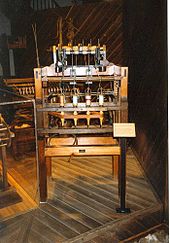Waterframe


The Waterframe was the first spinning machine to be driven by a water wheel independently of human power . The name is an English word creation from water (water) and frame (frame, frame).
The Waterframe was invented by the English wig maker Richard Arkwright in 1769 and a patent applied for immediately afterwards . In 1771 he and her built the world's first industrial cotton mill in Cromford . In contrast to the technical forerunner Spinning Jenny , the Waterframe processed the raw material continuously and could therefore be operated by an unskilled worker who had nothing to do but replace filled spindles with empty ones and put the torn threads back on. Thanks to the drive with an external energy source, the waterframe could reach any size, so machines with several hundred spindles were not uncommon. Machines of this size could only be powered by steam engines via transmissions .
In terms of its process, the Waterframe is a wing spinning machine , now called a Flyer . This process is still used today for roving slivers . Spinning on the waterframe requires very long cotton fibers , for which only very specific types of cotton bushes could be used. The fibers fed in are stretched between weight-loaded rollers , then twisted by the rotating wing and wound up by the rotating spindle.
In 1783 Johann Gottfried Brügelmann copied the Waterframe using industrial espionage for the Cromford textile factory in Ratingen , the first factory in continental Europe . A functional model can be viewed in the permanent exhibition there.
In the 18th century, the waterframe was suitable for mass production with the help of unskilled labor, and so it was the skilled textile workers who, as machine storms , mainly destroyed the factories with the waterframes during the industrial revolution .
See also